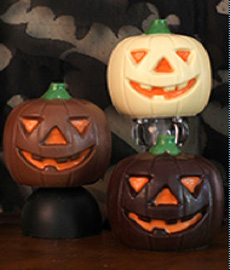HALLOWEEN: Best Chocolate Witch

Bewitching in dark or milk chocolate. Photo courtesy Li-Lac Chocolates. |
We’ve been looking around, and think we’ve found the best chocolate witch for Halloween. Eight inches tall and weighing in at 14 ounces of solid chocolate, the Big Halloween Witch from Li-Lac Chocolates is our favorite this season. There are many nifty chocolate molds around, but we like the garments and expression of this particular paranormal practitioner of magic. With her crooked smile, flowing robe and pointed hat, carrying her broomstick and jack-o’-lantern, she’s almost too cool to eat. The chocolate witch is made fresh to order in milk or dark chocolate, and is certified kosher (dairy) by OU. Get yours at Li-LacChocolates.com, or at the company’s retail stores in New York City. The 90-year-old chocolatier has been delighting New Yorkers for generations. We love to sneak in for a bite; or, in the case of this witch, many bites. |
|
|
THE HISTORY OF TRICK OR TREATNG “Guising” traditions began as a Christian practice in the Middle Ages, when children and sometimes poor adults would dress up in the costumes and go around door to door during Hallowmas (All Saints Day, November 1st, the day after Halloween). They begged for food or money in exchange for songs and prayers for the dead (the latter called “souling”). That tradition was ported to the U.S., with children going door to door for treats in exchange for reciting a poem or singing a song. Bonfires, a European tradition on All Hallows Eve (Halloween), were also held. The term “trick or treat” didn’t emerge until the 1920s. The first printed reference is found in a newspaper from 1927 [source]. While today the “trick” portion of trick-or-treat is usually an idle threat, it began with youthful participants who insistently rang doorbells and promised worse (knocking over trash cans, sticking a pin in the bell so keep it ringing, papering the house) if they did not get a treat. The residents paid the price in candy or other treats, and the costumed visitors went on to the next house. Individual trick-or-treating evolved in some locales in the 1960s and 1970s, into community events for the whole family, house parties for kids, and other activities that circumvented the need to send children to strange houses (and the reverse, to avoid having to opening one’s door to strangers). |
||
|
THE HISTORY OF HALLOWEEN CANDY
For hundreds of years, Halloween came and went with no candy! Costumed children going door-to-door received everything from homemade cookies and cake to fruit, nuts, coins and toys. It wasn’t until the 1950s that candy manufacturers began to promote their products for Halloween. In the 1960s, following a hoax that miscreants had inserted pieces of glass into apples and other treats, factory-made, wrapped candy became the only acceptable treat to hand out. Producers of the most popular candies made miniatures, making a household’s candy giveaway more affordable. Here’s some trivia about popular Halloween treats: |
Chocolate pumpkins from Woodhouse Chocolate. |
|
|
|
||
